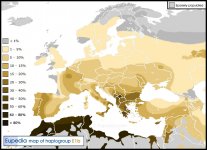Ever since getting into European genetics, I've been fascinated by how dense E1b1b is in Kosovo. Initially I assumed this might be the result of Pelasgians who took longer to assimilate, but I've since come to realize that J2 is instead most associated with a Pelasgian presence (though E1b1b was certainly prominent.)


So, are there any civilizations in particular to whom E-V13 in the Balkans might be connected? I've found alleged links to Cardium Pottery and "Old Europe," but have also heard that few samples confirm this. I thought that the Vinca culture might be a potential ancestor, but I've heard that they're mostly linked to G2a. And do the known ancestors (Paeonians, Dardanians, etc) of Kosovans have any peculiar myths or societal features which might point to a past linked to E-V13?
Any information on this would be appreciated.
Edit: If any moderators would rather move this to the E1b1b subforum, I'd be perfectly fine with that.


Any information on this would be appreciated.
Edit: If any moderators would rather move this to the E1b1b subforum, I'd be perfectly fine with that.




